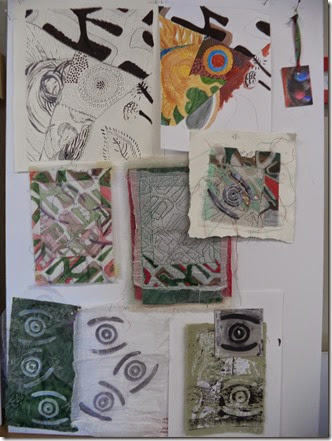I chose to change the fabric from previous chapters, to one that was easier to withdraw threads. It is a natural cotton fabric which was obtained from Art Van Go and is that used by Jan Beaney and Jean Littlejohn. I dyed this fabric using the same technique as in Chapter 4 using better strength dye and ensured cling film was between layers and left over night before rinsing. (You will find that going on to Chapter 7 I use a linen scrim). The pieces worked on were generally smaller than earlier, matching the size of paper made, 10cm x 15 cm. All withdrawn threads were saved for later use.
Hand stitching
Samples 1 and 2 were not dyed, using red on the natural cotton (10cm x 25cm):
- Ribbons, string, threads, lengths of fabric and other materials were stitched through bands of withdrawn threads, or sequences of stitches including running stitch, back stitch, herringbone and raised chain
- Needle weaving on bands of withdrawn threads – including, in sequence: blocks with pairs of threads; tapered shapes moving threads gradually across the design; rows of raised chain; tapered pattern, alternating increasing and reducing the length of stitches to form triangles; blocks to form chequered effect and series of columns in blanket stitch, chain and open chain, working down columns
Since scanning the above have added a guitar string across the sample
Particularly enjoy doing raised chain. Should have painted the stick red.
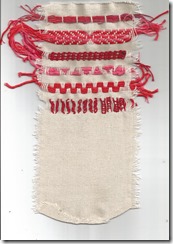 Sample 2
Sample 2Before working on other samples, dyed 4 A3 size pieces of fabric using dye from Chapter 4, but changed the consistency to 100ml Dylon dye mix, 50 ml salt and 50ml soda. Used red and green painting on patterns some with a musical theme. With spare dye I coloured threads leaving them to soak overnight, then to dry naturally.
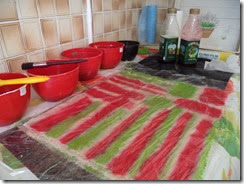
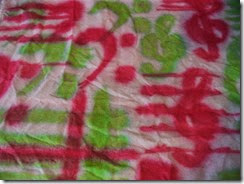

Samples 3 and 4
These required a grid formation of withdrawn threads leaving a border, into which threads could be run.
It took a while to get the hang of it, helped by an Embroiderer’s Guild friend. Now I enjoy using this technique.
Sample 3 shows diagonal stepped stitching across bars, needle weaving over 1, 2 or 3 stitches at a time or blanket stitch (Hardanger is based on this form). The fringe threads were attached either by cross stitch in a row or by threading the bundles of threads through the fabric
Sample 4 shows diagonal stepped stitching across intersections using running stitch, back stitch, chain stitch or fly stitch (Russian Drawn Ground work is based on this form). Used running stitch, back stitch and half cross stitch to trap the fringe threads.
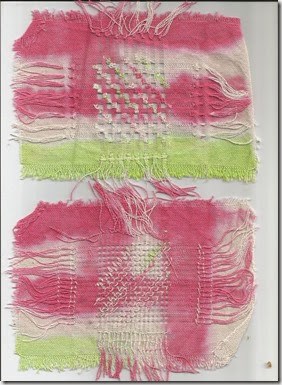 Samples 3 & 4
Samples 3 & 4Machine stitching
Sample 5
Shows vertical lengths of zig zag stitch along lengths of withdrawn thread.
This sample also includes tucks (see also Sample 6) made from wide withdrawn thread columns folded and joined with a row of zigzag stitch. The piece was finished using hand stitching, rows of stitching fly stitch, blanket stitch, raised chain and running stitch using bundles of threads withdrawn from this and earlier pieces. A wave of tucks were made by hand stitching a group of threads.
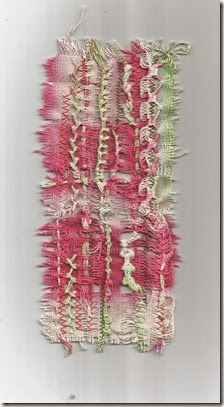 Sample 5
Sample 5 I was pleased with this piece, showing overlaying of the colours and texture from the hand stitching on the different dyed areas.
Samples 6 and 7
These samples show different uses of zigzag stitching.
Sample 6 shows tucks made by withdrawing wide columns of thread, folding then joining them together with zigzag machining. The central column has been further manipulated using hand stitching to produce a wave effect. Lovely texture is produced.
Sample 7 shows the same as in Sample 3 where bars using a stepped sequence and ends of threads are trapped with zigzag machine stitching . It can be very fiddly.
 Samples 6 & 7
Samples 6 & 7Sample 8 clearly shows zigzag stitching along bars between columns of withdrawn thread (a musical theme – using the coloured fabric for symbols and columns as the lines on a musical score) where the stitching forms the lines and the withdrawn thread the space between the lines. I am hoping to develop another piece to get other musical symbols in place.
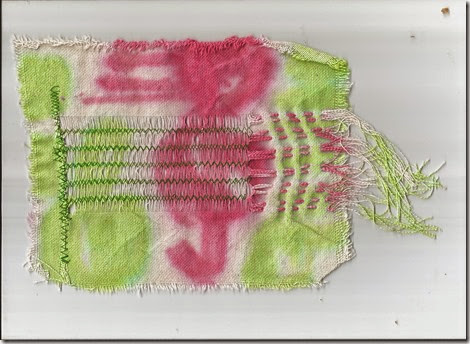 Sample 8
Sample 8Samples 9 and 10 show further methods using zigzag stitch on the machine, but using a wing needle to help gather more threads.
Sample 9 is zigzag stitching in varying directions on withdrawn threads, vertically and horizontally. Some threads are only partially withdrawn to provide an haphazard fringe effect and to stagger the colours used. The zigzag widths and lengths were moved whilst stitching to give a variety to the pattern. The top thread was green and the spool thread variegated red. In order to mix the colours turned the fabric over. So the back is similar to the front!
Sample 10 includes zigzag stitching across bars (not stepped), or in areas where threads were not withdrawn. The grid was made from a varying number of withdrawn threads providing smaller and larger holes accentuated with zigzag stitch around them. Some bars that were stitched left single threads alongside, left to give a different effect. Also needle weaving and blanket stitch was used. The fringe threads were either stitched down with zigzag, bundles of threads sewn together into the border or knotted and hand stitched in place. What could be added are lengths of fabric or other threads woven through the holes, but felt this sample could be left (see also samples 1 to 4 for woven through techniques and Sample 5 for added hand stitching)
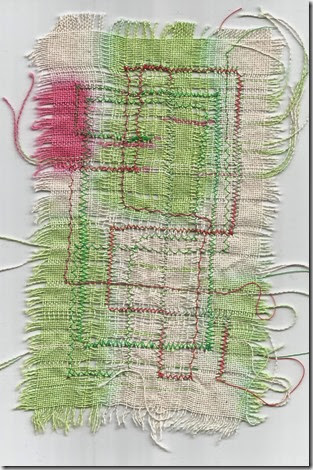 Sample 9
Sample 9 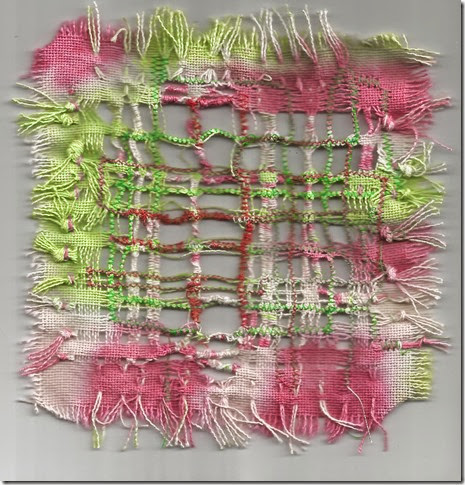 Sample 10
Sample 10I found this chapter challenging but now that I am beginning to get to grips with the techniques hope to use some within my final piece.
Finally thoroughly enjoyed the Summer school this year.
Our tutor was Alison King who introduced us to a new way of viewing pattern and colour, reverse applique, printing and stitch.
Here I am absorbed in the task in hand. Applying her techniques with Module 4 in mind . These are the pieces I completed, considering a panel for a book cover.
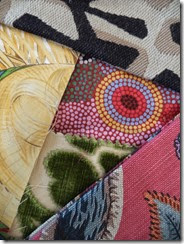
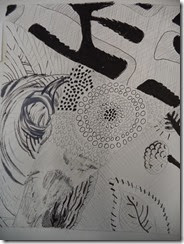
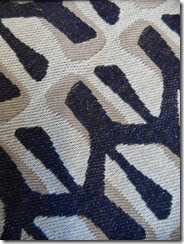

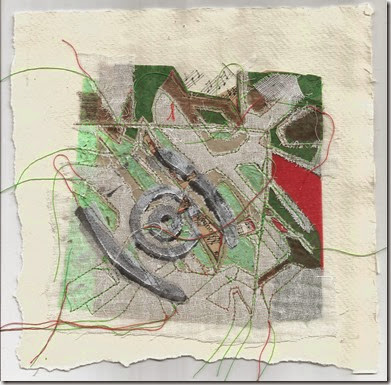
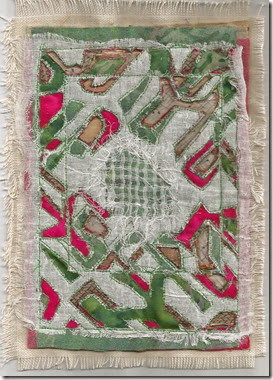
Sample in paper, no dots! A4 Book Panel reverse applique plus grid! Decided to leave it free of dots
….and the display board showing how I got to where I got!
